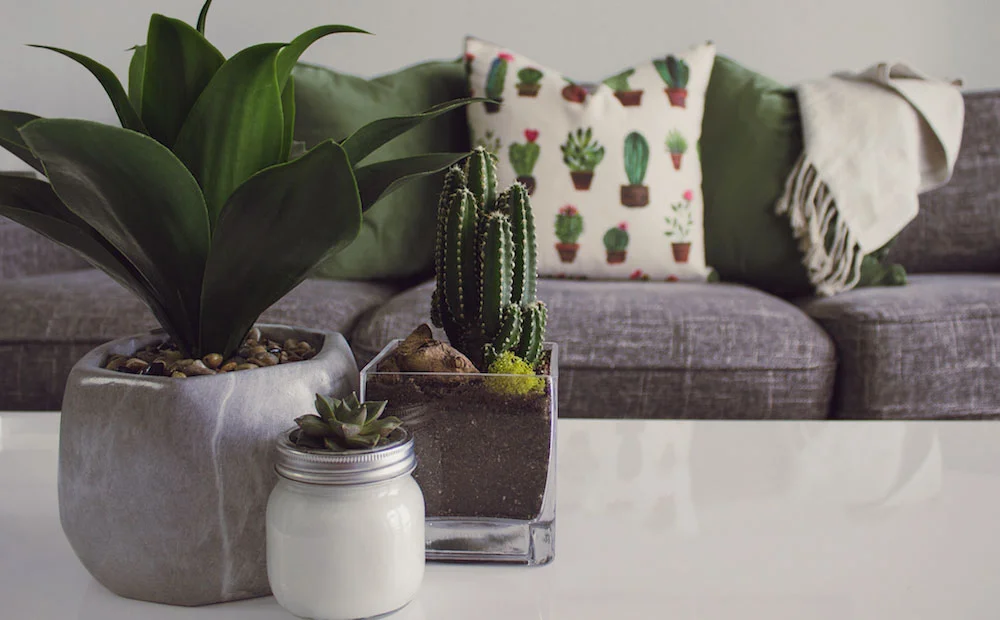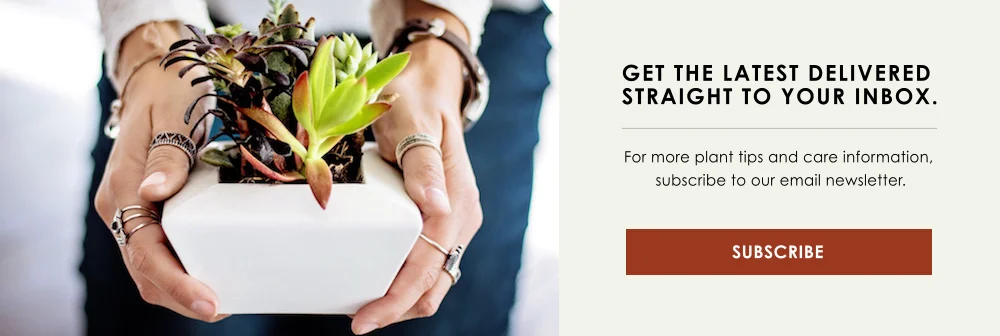PLANT PARENTING 101
Having a houseplant around is the most zen way to bring nature indoors. We reap many benefits by having these wonderful, leafy companions with us through every season - from better air quality to a more beautified space.
Bringing plants into our homes from their native outdoors does come with a little bit of parenting. After all, you are taking care of a living thing that doesn’t speak your language when trying to ask for what it wants! Getting used to life on the inside takes a bit of transitioning, but for most plant parents it’s pretty straightforward:
MATCHMAKING - PICKING THE RIGHT PLANT
Unlike kids, when you become a plant parent, you have the ability to pick and choose the perfect fit for the lifestyle that you already have. That means you and your houseplant can start off in the right direction without much work. When it comes to plant parenthood, the first step is to pick a plant that works with you and your space.
Take a look at your lifestyle. Are you a busy bee that spends a lot of time working and running around, or maybe a free spirit that isn’t the best with remembering routines? You might want to choose a plant that’s low-maintenance enough that can survive fairly independently, without stressing you out over the daily care. Something hardy like a ZZ Plant, snake plant, spider plant, succulent, or cactus might be the perfect fit. There are lots out there that will steal your heart while still being tough enough to embrace a little neglect.
If you’re more flexible with your home life and are looking for a challenge or a plant to get a little more engaged with, you might want to choose a leafy friend that you can dote over a bit more. For a pickier plant that will have you working with them more often, you could choose something like a stylish Fiddle Leaf Fig, or some gorgeous ferns, bromeliads, or calathea. Pickier plants can be rewarding, but they need someone that has the time and consistency to put the work in.
Have a look at your living space. The good news here is that houseplants are an incredibly diverse collection of plants, so there is almost always something to fit in nearly any type of space that you have in your home - sun-filled or dreary. Have a look around for where you imagine you want a plant, and then look at things like the lighting and temperature conditions in that area. Do they get lots of sunlight? Or is it a dimmer corner you want to brighten up with something green? Also, is it close to drafty doors and windows that might cause temperature fluctuations, or is it tucked safely in a corner where things are comfortably consistent?
There’s something to fit almost anything, but matching your space to the needs of your plant is the right way to make sure that everyone is happy, and that your plant thrives, instead of fighting to survive. The better the spot you chose to meet your plant’s needs, the less difficult the transition will be, and the healthier your plant will look.
Once you’ve settled on a spot and brought your plant home, you won’t want it to be moving around. Plants don’t have the liberty to get up and walk to new spots in the wild, so you can imagine that adjusting to sudden changes in lighting and location can be stressful and your plant may take a while to acclimate. Unless your plant needs a rescue from conditions that just aren’t working, you’ll want to keep them where they are if possible.
KEEPING YOUR PLANTS ALIVE - FOOD AND WATER
Plants, like every other living thing - need a few essentials to survive. They’ll need food and water to get by, but different plants have different needs when it comes to how much and how often. While there are some variables - whether your plant is used to a boggy home, an arid desert, or a steamy jungle - a few things are consistent across the board:
There is such a thing as too much water! When your plant is quenched, the roots stop being able to take up extra moisture, so the rest just sits in the soil until it evaporates or is taken up later. Too much water sitting stagnant in the soil, and your roots not only can’t get any air, but they could start to rot. The smart way to water your plant is to only water as much as your plant needs, and only when it needs watering. Poke your finger into the top layer of soil, and only water when the dirt is dry up to your first knuckle. Following this will help you find a watering schedule that is the perfect fit for you, your home, and your plant.
Houseplants have a small world and a relaxed growing schedule in the comfort of your home, and they’re designed to grow for the long haul - so they aren’t terribly hungry growers. Most of what they need can be found in their potting soil, so they often don’t need much fertilizer, if any. If you do feel the need to fertilize, be sure to be gradual and gentle with dosage, as delicate roots won’t have much relief from strong fertilizers trapped in their containers. If you choose to fertilize at all, keep it to springtime feedings of a half-dose only.
POTS OF ALL SHAPES AND SIZES
Containers should be the easiest part of being a Plant Parent, but it’s actually something that calls for at least a little thought. After all, it’ll be your plant’s home until they outgrow it.
Your fresh-from-the-store plant probably comes in a plastic container that is less than exciting to look at. Use the store container as a guide to find a container that fits your plant and a little expected growth. Don’t overshoot it and leave tons of extra room (which can harm your plant in the long run!), but aim for a Goldilocks solution that has a little room, but not too much. Pick something that is at the most twice the capacity of your current container, or only one or at the very most two sizes up.
If your plant is happy and healthy, you can expect it will eventually outgrow its home - just like a kid needing new shoes and jackets almost every season. If your plant is dropping leaves, stops growing, or if you start to see visible roots at the top or bottom of the container, it’s time for more room.
Choose a container that you love the style of, but make sure that it is a shape and has drainage to match the needs of your plant. If you fall in love with a particular container that doesn’t suit your plant’s needs, you can always keep your plant in a properly drained or proportioned container hidden inside of a decorative container that you love the look of.
LISTENING TO YOUR PLANT
Bringing home your new houseplant is like bringing home a precious baby from the hospital - you are in charge, but you don’t know what exactly your baby wants because it doesn’t speak your language! While conversing with your plant isn’t likely, it’ll still be able to give you the hints you need to keep it alive.
It might not talk, but your plant will tell you if it needs something. S.O.S. signs like stunted growth, wilting, discoloration, burnt leaf tips, or dropped leaves will tell you when your plant needs something - like more or less light, water, food, or even air. You don’t have to speak the same language - you just have to be ready to listen to what your plant tells you.
When bringing home your first houseplant, it’s easy to feel overwhelmed, but there’s lots of help out there to decode of some of the mystery. With these tips and some help at the garden center, you’ll graduate from ‘plant parent’ to ‘plant collector’ in no time.







